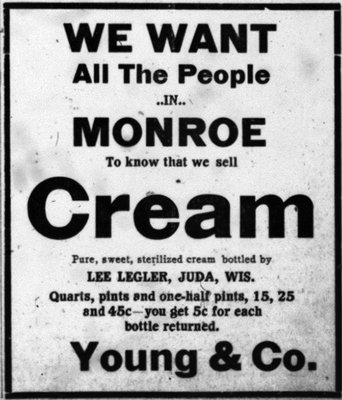“The Lewis restaurant is the popular headquarters for meals and lunches. Meals 25 cents, lunches 5 cents up, Sunday dinner 35 cents. Sandwiches, all kinds, 5 cents. Oysters served in all styles. Soft drinks and cigars.” This was an ad from the Monroe Evening Times on October 22, 1908. Granville Lewis opened a restaurant in June 1908 in the east part of what later became the Marco’s building (across from the post office) and closed it about a year later.
Nine months earlier Frank Millman, who operated a dry goods, clothing, and hardware store in the Syndicate Block, had advertised gent’s suits for $10, $12, or $14. Ladies’ suits sold for $4 and up and boys’ suits from $3. He also advertised that ladies’ coats and misses’ coats and jackets were “at your own price.” I have no idea what that meant. It sounds like he might negotiate a price. He also said, “We can suit you on prices of lace goods and dress goods.”
Whenever I see ads like this, I think that I would like it if we had the same prices today. But we must also consider what the wages were at the time. On February 13, 1908, there was a news story that said that potatoes were retailing for $1 a bushel in Monroe. Imagine planting potatoes in the spring, tilling them, digging them in the fall and selling them to a retailer who will then sell them for this price. The article also stated that potatoes were selling in Chicago for 83 to 90 cents a bushel in carload lots. As seen in the Young advertisement printed here from December 15, 1908, a quart of cream sold for $0.45. The cream was produced and bottled by Lee Legler, rural Juda. The consumer would receive five cents back when the empty bottle was returned to Young & Co.
There was a notice in the paper on April 2, 1910 that, because of the “advance in cost of materials and general expenses,” the Monroe plumbers were increasing their hourly charge for labor from 50 to 65 cents beginning on April 4 E. N. Churchill, Niles & Hartnatt, and Monroe Plumbing and Heating were the plumbers listed on the ad.


On June 9 of the same year the members of the Green County Medical Society agreed that their fees would all be the same. They would charge $1.50 for a visit in the city (or village) if it was between 6 a.m. and 9 p.m. If it was during the night, the charge was $2.00. A visit to the country was charged at 75 cents per mile one way with an additional charge of $1.00 during the day or $2.00 at night. The doctors listed in the ad were: F. L. Hodges, W. B. Monroe, W. G. Bear, N. A. Loofbourow, J. F. Mauerman, George Seiler, R. B. Clark, L. A. Moore, W. B. Gnagi, F. J. Helgeson, S. R. Moyer, H. B. Gifford, and S. R. Moyer.
An article printed before Thanksgiving that year stated that turkey was a real luxury. Not only was the price high, but the city demand was so high that it was “a wonder that the bird is on the local market.” The fowl was to retail for 22 cents a pound and every dealer was offered this price for all he could ship to Chicago. One dealer was even offered an additional two cents per pound for all he could ship before Thanksgiving. Geese were selling for 12.5 cents, ducks for 15 cents, and chickens at 14 and 15 cents. These birds seemed to be plentiful. Eggs and butter were also included on the list of luxury items for Thanksgiving in 1910. Eggs were retailing for 30 cents a dozen while creamery butter was selling for 37 cents.
There was a newspaper article the following year that stated there were plenty of turkeys available in 1911 and they were then selling for 20 cents a pound. The editors stated that there would be plenty of chickens, ducks, and geese for those who could not afford turkey. Geese were selling for a “shilling a pound” while the abundance of chickens were “retailing at the reasonable price of 12 to 14 cents.” Ducks were again selling for 15 cents per pound. Cranberries were also to be found in large quantities and were the choicest of fruit. Merchants claimed that they were the best that had ever been sold on the local markets and were selling for 13 cents per pound. The berries were fine and large and expected, as usual, to be “prominent among the delicacies on the Thanksgiving table.” The price was the same as it had been the previous year.
I used to think how wonderful it would be to be able to purchase some of the items like those listed here for these prices today, but it wasn’t such a great deal when we consider what people earned back then. Young people today can’t imagine working for the amount we did in our early years. I believe that I made $1.45 an hour at Schultz Pharmacy in 1967. If I remember correctly, I could buy a 16-ounce glass bottle of soda from a vending machine for 10 cents at that time. It is all relative. I often think of how expensive long distance calls were 50 years ago compared to our earnings. Photo film processing was another one that I felt became cheaper as time passed. Of course, film is something that many young people might not understand today.
— Matt Figi is a Monroe resident and a local historian. His column will appear periodically on Saturdays in the Times. He can be reached at mfigi48@tds.net or at 608-325-6503.




